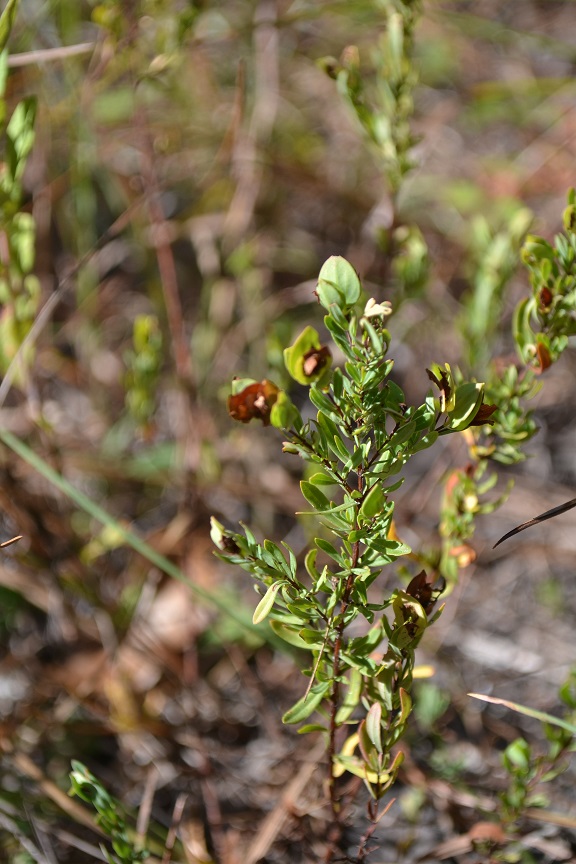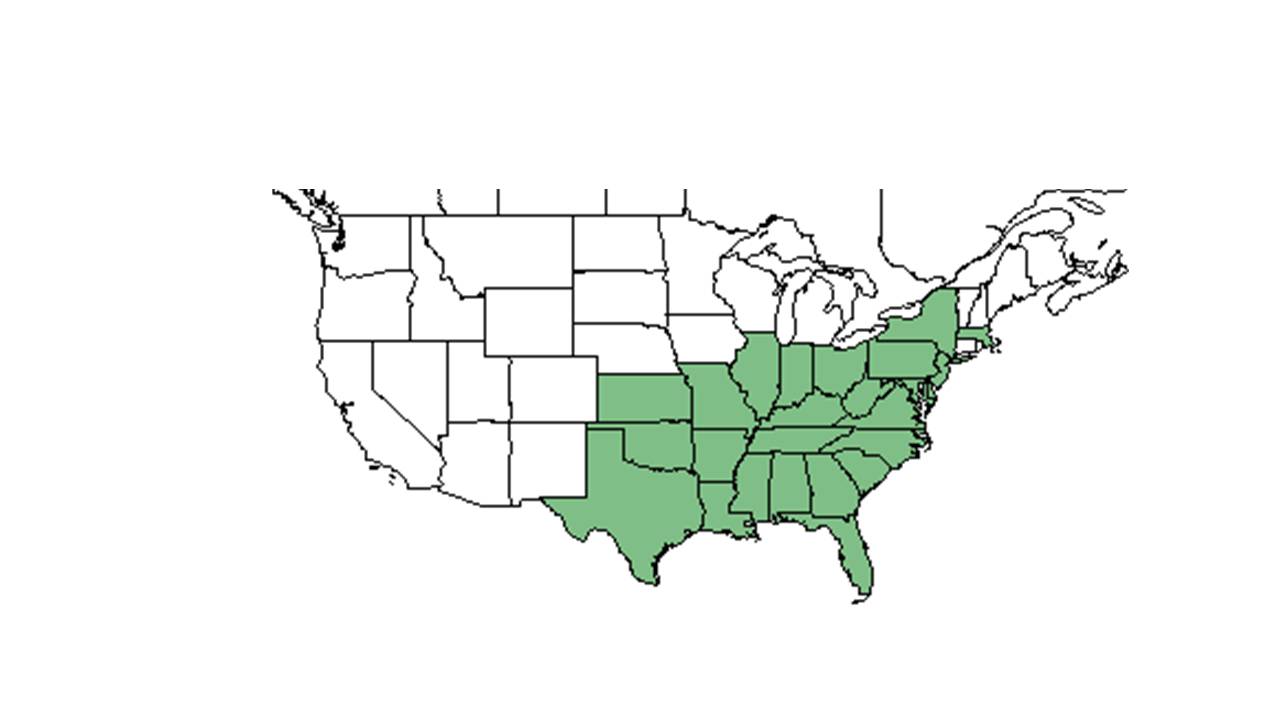Difference between revisions of "Hypericum hypericoides"
(→Conservation and management) |
(→Ecology) |
||
| Line 45: | Line 45: | ||
===Seed dispersal=== | ===Seed dispersal=== | ||
This species is thought to be dispersed by gravity. <ref>Kirkman, L. Katherine. Unpublished database of seed dispersal mode of plants found in Coastal Plain longleaf pine-grasslands of the Jones Ecological Research Center, Georgia.</ref> | This species is thought to be dispersed by gravity. <ref>Kirkman, L. Katherine. Unpublished database of seed dispersal mode of plants found in Coastal Plain longleaf pine-grasslands of the Jones Ecological Research Center, Georgia.</ref> | ||
| − | + | ||
| + | ===Seed bank and germination=== | ||
| + | It was found as a prevalent member of the seed bank at a loblolly pine plantation restoration site in southwest Georgia.<ref>Andreu, M. G., et al. (2009). "Can managers bank on seed banks when restoring Pinus taeda L. plantations in Southwest Georgia?" Restoration Ecology 17: 586-596.</ref> | ||
===Fire ecology=== <!--Fire tolerance, fire dependence, adaptive fire responses--> | ===Fire ecology=== <!--Fire tolerance, fire dependence, adaptive fire responses--> | ||
Revision as of 16:15, 24 May 2019
| Hypericum hypericoides | |
|---|---|

| |
| Photo taken by Kevin Robertson | |
| Scientific classification | |
| Kingdom: | Plantae |
| Division: | Magnoliophyta - Flowering plants |
| Class: | Magnoliopsida – Dicotyledons |
| Order: | Theales |
| Family: | Clusiaceae ⁄ Guttiferae |
| Genus: | Hypericum |
| Species: | H. hypericoides |
| Binomial name | |
| Hypericum hypericoides (L.) Crantz | |

| |
| Natural range of Hypericum hypericoides from USDA NRCS Plants Database. | |
Common name: St. Andrew's cross
Contents
Taxonomic notes
Synonyms: Ascyrum hypericoides Linnaeus var. hypericoides; Ascyrum hypericoides Linnaeus var. oblongifolium (Spach) Fernald; H. hypericoides Linnaeus ssp. hypericoides; Ascyrum hypericoides Linnaeus; Ascyrum linifolium Spach
Description
Hypericum hypericoides is a perennial shrub species.
“Usually glabrous herbs or shrubs. Leaves usually punctate, simple, opposite, entire, usually sessile or subsessile, exstipulate. Inflorescence basically cymose; flowers perfect, regular, bracteates, subsessile or short-pedicellate, sepals 2, 4, or 5, persistent; petals 4 or 5, usually marcescent, yellow or pink; stamens 5-numerous, separate or connate basally forming 3-5 clusters or fascicles, filaments usually persistent; carpels 2-5, stigmas and styles separate or fused, ovary superior, 1-locular or partly or wholly 2-5 locular, placentation axile or parietal. Capsules basically ovoid, longitudinally dehiscent, styles usually persistent; seeds numerous, lustrous, areolate, cylindric or oblong. In general our species form a polymorphic complex with many intergrading taxa.” [1]
"Shrub 3-10 dm tall with erect or ascending, wing-angled. Leaves elliptic, linear, or oblanceolate, 8-26 mm long, 1-7 mm wide, acute or obtuse, base cuneate, notched. Flowers solitary, axillary, or ins mall cymules; bracts paired, at base of sepals; pedicels ascending, 1-5 mm long. Outer sepals 2, ovate, or widely elliptic, 5-12 mm long, 3.5-7 mm wide, acute, base frequently subcordate, inner sepals usually obsolete; petal 4, 6-10 mm long; styles 2, partly fuse, 0.5-1 mm long, ovary 1-locular. Capsules ovoid, 4-9 mm long, 2.5-4 mm long, 2.5-4 mm broad; seeds black, ca.1 mm long."[1]
Distribution
It is distributed from New Jersey, western Virginia, central Kentucky, southeastern Missouri, and central Oklahoma south to southern Florida and eastern Texas. It is also native to the West Indies, Mexico, and South America.[2]
Ecology
Habitat
Generally, H. hypericoides can be found in various woodlands and dry forests.[2] It occurs in wet or moist loamy soils and semi-shady to open light conditions. It can be found in annually burned longleaf pineland, wetland depressions, limestone glades, and by ponds. However, it also appears in disturbed areas including roadsides, open fields, and pine plantations.[3] It has been associated with areas that are heavily logged, herbicided for woody plants, and burned several times, as compared to unlogged areas that are selectively herbicided for hardwoods and infrequently burned.[4]
Associated species include Pinus palutris and Pinus elliottii.[3]
Phenology
H. hypericoides generally flowers from May until August.[2] It has been observed flowering in March, April, June, July, and September, while fruiting has been observed in September.[3][5]
Seed dispersal
This species is thought to be dispersed by gravity. [6]
Seed bank and germination
It was found as a prevalent member of the seed bank at a loblolly pine plantation restoration site in southwest Georgia.[7]
Fire ecology
This species has been found in habitat that is burned annually, indicating some level of fire tolerance. [8]
Use by animals
It consists of approximately 2-5% of the diet of various large mammals and terrestrials birds.[9]
Conservation and management
On the state level, Hypericum hypericoides is considered vulnerable in the state of Delaware.[10]
Cultivation and restoration
Photo Gallery
References and notes
- ↑ 1.0 1.1 Radford, Albert E., Harry E. Ahles, and C. Ritchie Bell. Manual of the Vascular Flora of the Carolinas. 1964, 1968. The University of North Carolina Press. 709-713. Print.
- ↑ 2.0 2.1 2.2 Weakley, A. S. (2015). Flora of the Southern and Mid-Atlantic States. Chapel Hill, NC, University of North Carolina Herbarium.
- ↑ 3.0 3.1 3.2 Florida State University Robert K. Godfrey Herbarium database. URL: http://herbarium.bio.fsu.edu. Last accessed: June 2014. Collectors: Ann F. Johnson, Wilson Baker, Loran C. Anderson, Leon Neel, R. Komarek, R.A. Norris, R.F. Doren, Robert K. Godfrey, Andre F. Clewell, Kevin Oakes, Chris Cooksey, and Sidney McDaniel. States and Counties: Florida: Franklin, Jackson, Jefferson, Lee, Leon, and Wakulla. Georgia: Baker and Thomas. Texas: Orange. Other Countries: Dominican Republic.
- ↑ Cipollini, M. L., J. Culberson, et al. (2012). "Herbaceous plants and grasses in a mountain longleaf pine forest undergoing restoration: a survey and comparative study." Southeastern Naturalist 11: 637-668.
- ↑ Nelson, G. PanFlora: Plant data for the eastern United States with emphasis on the Southeastern Coastal Plains, Florida, and the Florida Panhandle. www.gilnelson.com/PanFlora/ Accessed: 12 DEC 2016
- ↑ Kirkman, L. Katherine. Unpublished database of seed dispersal mode of plants found in Coastal Plain longleaf pine-grasslands of the Jones Ecological Research Center, Georgia.
- ↑ Andreu, M. G., et al. (2009). "Can managers bank on seed banks when restoring Pinus taeda L. plantations in Southwest Georgia?" Restoration Ecology 17: 586-596.
- ↑ Florida State University Robert K. Godfrey Herbarium database. URL: http://herbarium.bio.fsu.edu. Last accessed: June 2014. Collectors: Ann F. Johnson, Wilson Baker, Loran C. Anderson, Leon Neel, R. Komarek, R.A. Norris, R.F. Doren, Robert K. Godfrey, Andre F. Clewell, Kevin Oakes, Chris Cooksey, and Sidney McDaniel. States and Counties: Florida: Franklin, Jackson, Jefferson, Lee, Leon, and Wakulla. Georgia: Baker and Thomas. Texas: Orange. Other Countries: Dominican Republic.
- ↑ Miller, J.H., and K.V. Miller. 1999. Forest plants of the southeast and their wildlife uses. Southern Weed Science Society.
- ↑ [[1]] NatureServe Explorer. Accessed: May 24, 2019